The Intel SSD 545s (512GB) Review: 64-Layer 3D TLC NAND Hits Retail
by Billy Tallis on June 27, 2017 6:00 AM ESTBAPCo SYSmark 2014 SE
BAPCo's SYSmark 2014 SE is an application-based benchmark that uses real-world applications to replay usage patterns of business users in the areas of office productivity, media creation and data/financial analysis. In addition, it also addresses the responsiveness aspect which deals with user experience as related to application and file launches, multi-tasking etc. Scores are calibrated against a reference system that is defined to score 1000 in each of the scenarios. A score of, say, 2000, would imply that the system under test is twice as fast as the reference system.
SYSmark scores are based on total application response time as seen by the user, including not only storage latency but time spent by the processor. This means there's a limit to how much a storage improvement could possibly increase scores, because the SSD is only in use for a small fraction of the total test duration. This is a significant difference from our ATSB tests where only the storage portion of the workload is replicated and disk idle times are cut short to a maximum of 25ms.
| AnandTech SYSmark SSD Testbed | |
| CPU | Intel Core i5-7400 |
| Motherboard | ASUS B250-PLUS |
| Chipset | Intel B250 |
| Memory | 2x 8GB Kingston DDR4-2400 CL17 |
| Case | In Win C583 |
| Power Supply | Cooler Master G550M |
| OS | Windows 10 64-bit, version 1703 |
Our SSD testing with SYSmark uses a different test system than the rest of our SSD tests. This machine is set up to measure total system power consumption rather than just the drive's power.
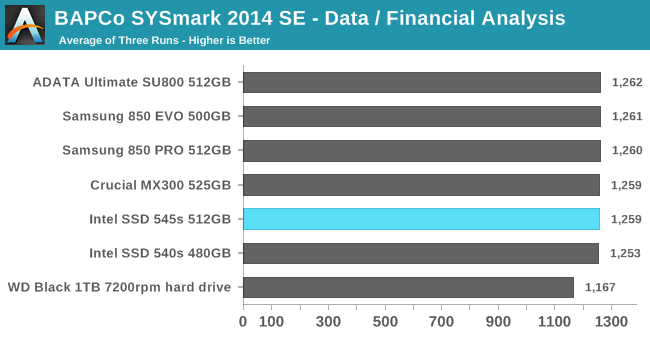
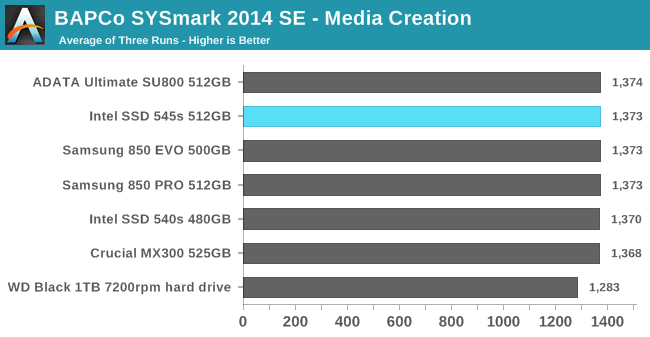
The SYSmark performance scores for data analysis and media creation are relatively insensitive to storage performance, as shown by our test system's score with a mechanical hard drive exceeding the normalized score of 1000 for the SYSmark reference system that uses a SSD and coming relatively close to the performance of our SSDs. The differences between these SATA SSDs are all within the variation between runs.
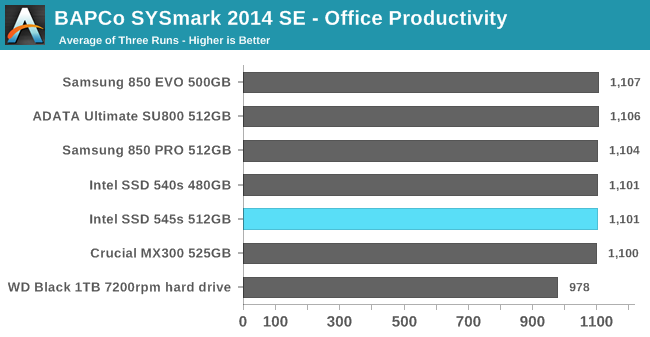
The office productivity test also shows very little dependence on storage performance, but the gap between the SSDs and the hard drive is a bit wider than for the first two usage scenarios, and the hard drive's detrimental impact on performance was enough to offset the CPU and RAM advantages our testbed has relative to the SYSmark 2014 SE reference system.
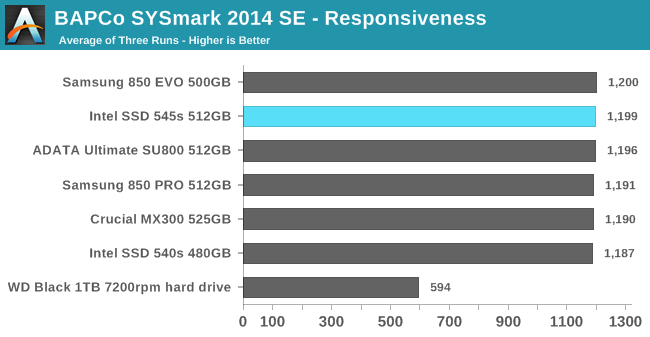
The SYSmark responsiveness benchmark is the most sensitive to storage performance, and all of the SATA SSDs are about twice as fast as the mechanical hard drive. The difference between SSDs is just barely larger than the variation between test runs, but it's enough that the slowest of the three runs for the 545s was faster than the fastest of the three runs for the Intel 540s.
Energy Usage
The SYSmark energy usage scores measure total system power consumption, excluding the display. Our SYSmark test system idles at around 26 W and peaks at over 60 W measured at the wall during the benchmark run. SATA SSDs seldom exceed 5 W and idle at a fraction of a watt, and the SSDs spend most of the test idle. This means the energy usage scores will inevitably be very close. A typical notebook system will tend to be better optimized for power efficiency than this desktop system, so the SSD would account for a much larger portion of the total and the score difference between SSDs would be more noticeable.
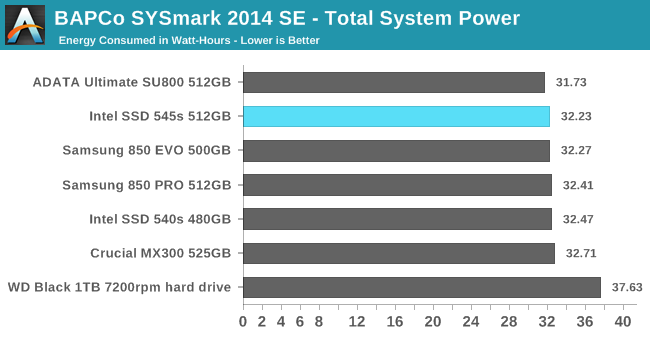
Rather than judging these scores by their percentage difference, it's probably more useful to consider the raw number of Watt-hours saved by using a more efficient SSD. The difference here between the best and worst SSD is just under 1 Wh, compared to a typical ultrabook battery capacity of around 50 Wh. Since the overall performance scores with each SSD were so close together, we know that the test runs took essentially the same amount of time and the differences in energy usage are due mostly to differences in the idle power consumption of the SSDs.










74 Comments
View All Comments
ddriver - Tuesday, June 27, 2017 - link
Great, now if they could just make a decent NVME SSD as well.ddriver - Tuesday, June 27, 2017 - link
Shame it took them entire 3 years to catch up to the 850 pro. Lets hope they will match the 960 pro before 2020 LOL.eddieobscurant - Tuesday, June 27, 2017 - link
They caught up with the 850 evo, not the proATC9001 - Tuesday, June 27, 2017 - link
True...but atleast for the first time in I think...ever, there's a drive that can compete with the EVO...hopefully we can see the EVO drives start to drop a bit.Alexvrb - Tuesday, June 27, 2017 - link
It IS nice to see some serious competition for the Evo. The 850 Evo is still my go-to for upgrading older systems from a mechanical drive.Now all I need is some serious price drops for lower-performance higher-capacity TLC drives and I can ditch the mechanical drive for mass storage too. Price:capacity hasn't budged much in recent memory. :-/
Impulses - Tuesday, June 27, 2017 - link
Hasn't budged at all... I bought two 1TB EVOs two years ago, almost to the date (Newegg invoice is dated 7/15/2015 for the first one), paid $340 for one and a couple weeks or a month later I managed to get a second one for $320.I was hoping two years later I could buy a 2TB drive to add to those for the same kinda money, instead the prices are exactly the same right now. The recent shortage and price hike didn't help, up until that point I remember prices steadily declining for at least 4-5 years straight...
I guess that couldn't last, historically the flash market has been more volatile (no pun intended) than not, the kind of stability that went on for a couple years aligned with Samsung's rise to SSD dominance were kind of rare in the grand scheme.
At this rate it's gonna be another 3+ years before I can score a couple good 2TB drives for $300/ea, meh.
andychow - Tuesday, June 27, 2017 - link
Nand is in shortage, has been for a few years. In the past, manufacturers would ramp up production, there would eventually be a surplus, and prices would crash. This time around, they've all decided to basically to ride out the shortage by telling their clients to wait.Alexvrb - Wednesday, June 28, 2017 - link
That seems strange. If they have the ability to ramp and fill demand, you would think one of these outfits would be happy to fill that gap and steal those sales. I thought perhaps they are unable to ramp the flash which is in greatest demand. I hope things get better with future heavily-layered TLC/QLC and upgraded controllers. I would like nothing more than to ditch my secondary mechanical drive for flash, but there's no way I'm spending that kind of money.ddriver - Thursday, June 29, 2017 - link
There is nothing strange about it, they know if flash is in shortage they will make more on every grain of sand they put into it. It is like an implicit mutual agreement to sustain an artificial shortage to make more money. And everyone is happy.They still sell as much SSDs as they can, but at a higher price. SSDs are available, but the supply is deliberately held tight, so there is a perpetual "they might run out" even though supply exceeds demand, it is carefully kept short. Nobody is waiting on flash, no company is missing on sales, they still sell as much as they can, they simply take care not to exceed demand by too much, so they do less work to get extra profits. It is an immensely great deal for them.
There is no motivation for any of the big players to end this shortage, because that would drive prices down, hurt their own margins and those of everyone else, and give the others an excuse for hostile actions in retaliation, which they don't really want, because even though to us they are apparent competitors, they are all in it for the money, and they have estimated that cooperating to keep supply tight will win them more than competing who will make the most or the best SSDs.
It sounds like it is illegal, but considering it is all common sense and they didn't have to collude in some dark room to make an explicit agreement to do so, it is perfectly legal as far as the corrupt justice system is concerned.
Error415 - Tuesday, October 3, 2017 - link
Yeah, it should be illegal for a company to decide not drive prices down by flooding the market with cheap products, shm.What sounds illegal to you is a text book example of a sustainable business model. No booms or busts just steady growth and profit.